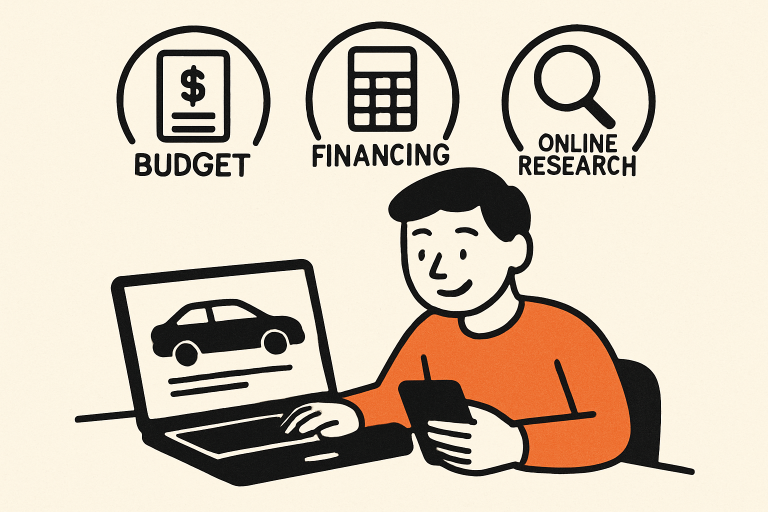Purchasing a car can feel overwhelming, but with current technology and the right plan, anyone can make smart, confident decisions without the usual stress. By following a streamlined approach and relying on proven resources, you can take control of every stage, from setting your budget to finally driving away in your new vehicle. For additional expert insights into navigating the car-buying process, learn more about choosing the right car, securing financing, and the importance of research to ensure you get the most value possible.
This comprehensive guide breaks down each stage of the car-buying journey and presents actionable tips to help you stay informed, make strategic decisions, and avoid common pitfalls. Leveraging online research and AI-powered options, you’ll save time and simplify paperwork while ensuring your investment is sound.
1. Establish Your Budget
Smart car buying starts with understanding your finances. Experts recommend keeping all monthly car-related expenses, including payments, insurance, and maintenance, within 10–15% of your net income. This ensures you maintain financial stability and avoid overextending yourself, no matter your transportation needs.
Set both a maximum budget and a target price before you shop. Include not only the sticker price, but also taxes, fees, and potential future repair or upgrade costs. This groundwork makes it easier to avoid impulsive decisions or dealer upselling and ensures you remain comfortable with the investment in the long term.
2. Leverage Online Research Tools
Modern car buyers benefit enormously from online resources. Platforms such as Autotrader, Cars.com, and Edmunds offer extensive vehicle listings, detailed comparisons, and genuine user reviews. These tools enable you to research various makes and models based on safety ratings, performance features, price variations, and ownership costs. Online comparison tools can save buyers significant time and money by preventing costly mistakes that often occur during dealership visits or sales pitches.
3. Secure Financing Pre-Approval
Obtaining pre-approval financing from a bank, credit union, or online lender before visiting the dealership simplifies negotiations and speeds up the paperwork process. Knowing your maximum loan amount and interest rate gives you more leverage, allowing you to walk away from unfavorable dealer rates or pressure tactics. Most lenders offer easy online applications, allowing you to compare rates and terms from home and gain valuable clarity on your budget before negotiating the final price.
4. Explore Virtual Showrooms and Test Drives
Dealerships increasingly offer virtual showrooms and digital experiences that replicate much of the hands-on feel of seeing a car in person. These platforms offer 360-degree views, detailed specifications, and sometimes even virtual or at-home test drives, allowing you to refine your vehicle search without multiple in-person visits. As highlighted in a CBS News report, virtual reality is transforming the car-buying experience by making it more immersive and accessible. These emerging digital experiences help buyers feel more confident, empowered, and informed when making final decisions.
5. Understand Total Ownership Costs
Looking beyond the sticker price is critical. The total cost of owning a vehicle includes insurance premiums, regular maintenance, fuel, licensing, taxes, and depreciation over time. Use online calculators to estimate these ongoing expenses; the Edmunds True Cost to Own calculator is a reliable tool. Factoring these costs in upfront protects you from unwelcome surprises later and ensures your purchase remains affordable for years to come.
6. Utilize AI-Powered Recommendations
Artificial intelligence (AI) tools are changing the car shopping landscape. Many car-buying platforms now use algorithms to match your preferences—such as budget, safety, fuel efficiency, or cargo needs—with vehicles available both locally and nationwide. These systems help speed up your search and introduce options you might have overlooked.
7. Consider Certified Pre-Owned Vehicles
If you want to maximize value while minimizing risk, certified pre-owned (CPO) cars are a smart choice. Backed by robust manufacturer inspections and extended warranties, CPO vehicles offer new-car confidence at a lower cost. They’re an appealing option for budget-minded buyers who want the assurance of quality, reliability, and protection from major repair bills usually found with new vehicles.
8. Stay Informed About Market Trends
Timing your purchase can provide added savings, especially when you’re aware of price fluctuations and market trends. With used car prices declining recently and interest rates routinely shifting, keeping up with the latest news can help you identify the right moment to buy or negotiate.
Following these strategic steps ensures a simpler and smoother car-buying process. By embracing digital tools, considering total costs, and staying up-to-date on industry changes, you’ll approach your purchase with confidence and make the best possible automotive choice for your needs and budget.
Driving Toward a Smarter Purchase
The modern car-buying journey has evolved far beyond traditional showrooms and sales tactics. With the integration of advanced research tools, digital showrooms, and AI-powered assistance, today’s buyers are more informed and empowered than ever before. By carefully planning your budget, thoroughly researching, and understanding all aspects of vehicle ownership, you can minimize risks and maximize value.
Whether you’re shopping for a brand-new vehicle or a certified pre-owned model, taking a proactive and technology-driven approach will streamline your experience. From pre-approval to virtual test drives, every step you take with preparation puts you in control of the process.
Ultimately, the key to a successful purchase lies in using every resource at your disposal. Armed with the insights and tools outlined in this guide, you’ll be ready to make a smart, confident decision that suits both your lifestyle and financial goals.


